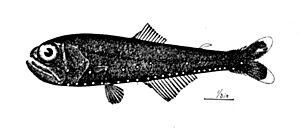Glacier lantern fish facts for kids
Quick facts for kids Glacier lantern fish |
|
|---|---|
 |
|
| Scientific classification |
The glacier lantern fish (scientific name: Benthosema glaciale) is a super common type of lanternfish. It lives deep in the ocean, especially in the northern North Atlantic! These fish are a really important part of the ocean's middle layer, called the midwater ecosystem.
What do they eat? Glacier lantern fish love to munch on tiny ocean creatures. Their favorite snacks include small crustaceans like copepods, krill, and amphipods. They also eat other small invertebrates that float in the water.
Contents
Where Do Glacier Lantern Fish Live?
The glacier lantern fish can be found in many places! They live all over the North Atlantic Ocean. You can also find them in the Mediterranean Sea.
In the eastern Atlantic, they swim from Guinea all the way north to the icy Kara Sea. In the western Atlantic, they are found from the northern edge of the Gulf Stream up to Baffin Bay and Greenland. They are even common in the deep fjords of Norway.
Deep Sea Homes and Daily Travels
These fish are known as "mesopelagic" fish. This means they live in the middle layer of the ocean. You can find them from the surface all the way down to about 1,400 meters (4,600 feet) deep! But they are most often found around 300 to 400 meters (980 to 1,300 feet) deep.
Glacier lantern fish are famous for their daily vertical migration. This means they move up and down in the water every day! At night, they swim up to shallower waters to find food. Then, during the day, they go back down to deeper, darker waters. However, not all of them migrate. Some fish might stay deep all the time.
Life Cycle and Growth of the Glacier Lantern Fish
The glacier lantern fish can grow up to about 10.3 centimeters (4 inches) long. That's about the length of a small smartphone! They can live for up to eight years, but most of them have a shorter life.
When Do They Become Adults?
These fish usually become adults when they are 2 or 3 years old. This is when they are ready to have their own babies.
Reproduction and Spawning
Most glacier lantern fish lay their eggs, a process called spawning, during the summer.
Interestingly, where they live can affect how they grow. Fish in the open ocean near Norway grow slower but get bigger than those living in the fjords. Fish in the Mediterranean Sea are usually smaller and don't live as long. They might even spawn throughout the whole year!
Gallery



